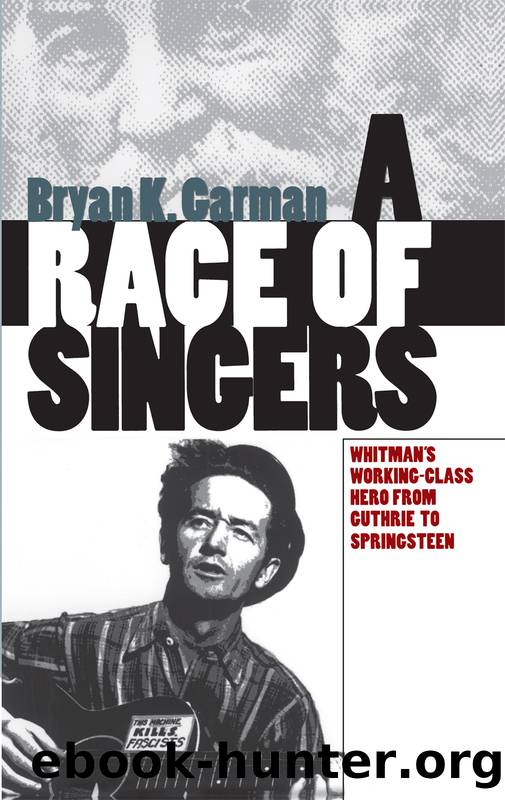A Race of Singers by Bryan K. Garman

Author:Bryan K. Garman [Garman, Bryan K.]
Language: eng
Format: epub
Publisher: The University of North Carolina Press
Published: 1990-05-15T00:00:00+00:00
SINGING WOODYâS SONGS
Twenty years after the release of Ashbyâs Bound for Glory, the music video network VH-1 aired a report on a tribute concert sponsored by the Woody Guthrie Foundation and the Rock and Roll Hall of Fame. At the conclusion of the broadcast, the young reporter remarked, âNot only did [Guthrie] do protest stuff, but he was a great songwriter.â18 Like Ashby, she suggested that art and politics were separate discourses, that Guthrieâs work could be neatly separated into didactic ballads and beautiful lyrics. Which type of Guthrieâs songs has become most prominent in the canon of American music? Which songs are most often performed and hence remembered, and what do these songs say about the politics of American cultural memory? An examination of the tributes staged in Guthrieâs honor reveals that his most famous songs are those that emphasize individual struggle and express their politics with ambivalence.
Since Pete Seeger led a cadre of musicians onto the stage of the Pythian in 1956, cultural workers have honored Guthrie in venues ranging from the Hollywood Bowl to Harvard University to Carnegie Hall, in cities ranging from Minneapolis to Austin to Okemah. They have recorded albums of Guthrie material on such labels as Vanguard, Folkways, Warner Brothers, and CBS.19 Thirteen of these events, to which artists such as Bob Dylan, Arlo Guthrie, Bruce Springsteen, Ronnie Gilbert, and Bernice Reagon have contributed, have disseminated a more comprehensive representation of Guthrieâs politics to a sizable national audience, but they too often expurgate the historical and ideological content of the original lyrics and struggle to balance collective politics and individualism. Perhaps the cultural productions most influential in shaping Guthrieâs legacy, these tributes tend to honor the artist rather than the causes for which he fought, and consequently, they often devolve into eulogies that acknowledge the horrors of his disease. By the time the participants in these affairs join hands to close the show with a sing-along of âThis Land,â any radicalism they articulate is often swept away in a surge of patriotism, nostalgia, and sorrow. Although most of these tributes identify their hero as a radical, they make certain that audiences understand that he was not too damned radical.20
Seeking to disconnect Guthrie from communist affiliation, artists typically perform songs from Dust Bowl Ballads, many of which articulate a disdain for wealth and privilege in republican terms, which, as we have seen, means they âprotest social and economic inequalities without calling the entire system into question.â21 âDo-Re-Mi,â the most frequently covered of these ballads, expresses the core of Guthrieâs populism by describing the disappointment that farmers face when they leave their dust-blown homes to start their lives anew in California, a place the song sardonically describes in Edenic terms. Hoping to find work in the fruit orchards, these families travel westward along Route 66, but when they arrive at the mythic âsugar bowl,â they taste only the most bitter fruits. Whereas border patrols welcome families who have the wherewithal to vacation or purchase a house, they sometimes refuse to admit poorer farmers who will likely drain state or federal relief funds.
Download
This site does not store any files on its server. We only index and link to content provided by other sites. Please contact the content providers to delete copyright contents if any and email us, we'll remove relevant links or contents immediately.
The Goal (Off-Campus #4) by Elle Kennedy(12452)
Kathy Andrews Collection by Kathy Andrews(10560)
Diary of a Player by Brad Paisley(6872)
What Does This Button Do? by Bruce Dickinson(5537)
Assassin’s Fate by Robin Hobb(5256)
Big Little Lies by Liane Moriarty(4894)
Pale Blue Dot by Carl Sagan(4018)
Sticky Fingers by Joe Hagan(3459)
The Heroin Diaries by Nikki Sixx(2943)
The Death of the Heart by Elizabeth Bowen(2911)
Beneath These Shadows by Meghan March(2731)
The Help by Kathryn Stockett(2710)
Confessions of a Video Vixen by Karrine Steffans(2684)
How Music Works by David Byrne(2540)
Jam by Jam (epub)(2497)
Harry Potter 4 - Harry Potter and The Goblet of Fire by J.K.Rowling(2422)
Strange Fascination: David Bowie: The Definitive Story by David Buckley(2371)
Petty: The Biography by Warren Zanes(2241)
Darker Than the Deepest Sea by Trevor Dann(2214)
